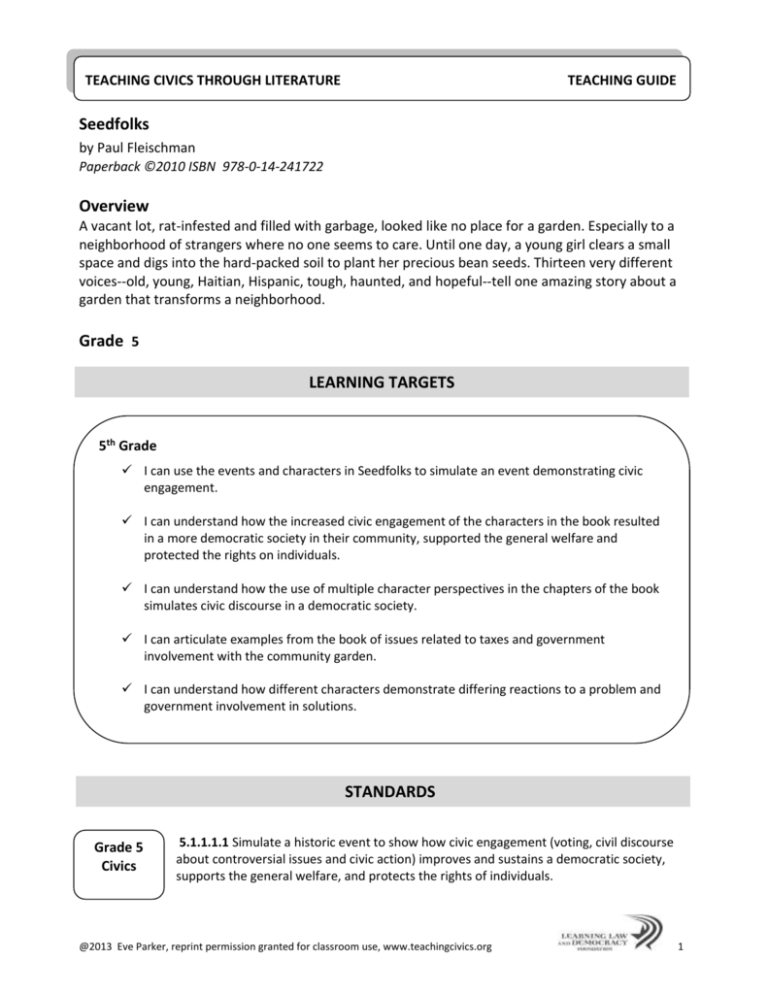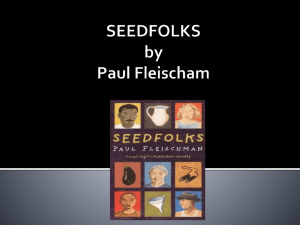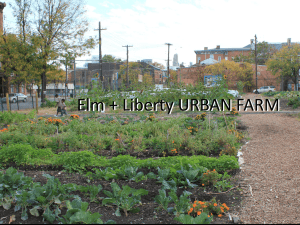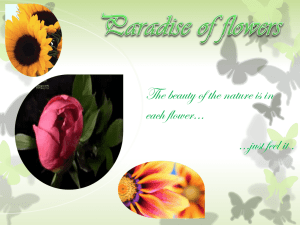Seedfolks - Teaching Civics
advertisement

TEACHING CIVICS THROUGH LITERATURE TEACHING GUIDE Seedfolks by Paul Fleischman Paperback ©2010 ISBN 978-0-14-241722 Overview A vacant lot, rat-infested and filled with garbage, looked like no place for a garden. Especially to a neighborhood of strangers where no one seems to care. Until one day, a young girl clears a small space and digs into the hard-packed soil to plant her precious bean seeds. Thirteen very different voices--old, young, Haitian, Hispanic, tough, haunted, and hopeful--tell one amazing story about a garden that transforms a neighborhood. Grade 5 LEARNING TARGETS 5th Grade I can use the events and characters in Seedfolks to simulate an event demonstrating civic engagement. I can understand how the increased civic engagement of the characters in the book resulted in a more democratic society in their community, supported the general welfare and protected the rights on individuals. I can understand how the use of multiple character perspectives in the chapters of the book simulates civic discourse in a democratic society. I can articulate examples from the book of issues related to taxes and government involvement with the community garden. I can understand how different characters demonstrate differing reactions to a problem and government involvement in solutions. STANDARDS Grade 5 Civics 5.1.1.1.1 Simulate a historic event to show how civic engagement (voting, civil discourse about controversial issues and civic action) improves and sustains a democratic society, supports the general welfare, and protects the rights of individuals. @2013 Eve Parker, reprint permission granted for classroom use, www.teachingcivics.org 1 TEACHING CIVICS THROUGH LITERATURE TEACHING GUIDE 5.1.1.1.2 Identify a public problem in the school or community, analyze the issue from multiple perspectives, and create an action plan to address it. 5.1.4.7.3 Identify taxes and fees collected, and services provided, by governments during colonial times; compare these to the taxes and fees collected, and services provided, by the government today. Grade 5 Language Arts 5.1.1.1 Quote accurately from a text when explaining what the text says explicitly and when drawing inferences from the text. 5.1.3.3 Compare and contrast two or more characters, settings, or events in a story or drama, drawing on specific details in the text (e.g., how characters interact). 5.1.5.5 Explain how a series of chapters, scenes, or stanzas fits together to provide the overall structure of a particular story, drama, or poem. 5.1.6.6 Describe how a narrator’ s or speaker’ s point of view influences how events are described. GUIDE A. Each of the characters in the book has a unique reason for becoming part of the garden. As a class, make a list of the characters and the reason each one starts gardening. “Civic engagement” is defined as individual or group actions to address a community issue or problem. Most of the characters get involved in the garden for personal reasons, rather than to address a community problem. Do some of the characters have a purpose of “civic engagement?” (Leona wants to force the city to pick up the trash, Sam wants to build community with neighbors) Do the gardeners as a group end up improving their community? How do their actions end up being “civic engagement?” Civics Standards: 5.1.1.1.1 5.1.1.1.2 Language Arts Standards: 5.1.1.1 5.1.3.3 B. What are some of the problems that seem to be issues for this Cleveland community? Think about the different situations described by characters and how some of these small stories demonstrate problems for the community as a whole. (Gonzalo – the isolation of immigrants who can’t communicate, Leona – poor services in poor neighborhoods, Sam – segregation, Nora – isolation of the elderly, Maricela – teen pregnancy, Amir – racism) Why does the author use many small stories to describe this community, rather than simply telling one story that describes the whole neighborhood? How does describing the community’s problems from multiple perspectives change your view of the neighborhood? How do the characters’ many perspectives fit together to create a solution to their problems? Can it solve all their problems? Civics Standards: 5.1.1.1.2 Language Arts Standards: 5.1.1.1 5.1.5.5 5.1.6.6 @2013 Eve Parker, reprint permission granted for classroom use, www.teachingcivics.org 2 TEACHING CIVICS THROUGH LITERATURE TEACHING GUIDE C. Leona is interested in getting the trash cleaned out of the vacant lot where the garden is growing. She approaches a number of government offices about it. On page 21 she describes calling city government, county government, state government and federal government offices. Why does she call so many different government offices? (She needs to find out who has responsibility for the lot.) Why does she call government offices at all? Why doesn’t she organize the neighbors to clean up the trash instead? (It needs to be hauled out of the neighborhood, which would be expensive. Taxes are collected by city government to pay for trash collection and removal.) When Leona doesn’t get results with phone calls, she uses another approach to get attention for the problem. What is it? (Takes garbage to the government office.) What do you think of this solution? Do you think it would work? Imagine you are the government official that Leona has a meeting with, how would you react to her solution? What are the downsides to taking this kind of action? What are some alternative actions that Leona might have taken? Civics Standards: 5.1.1.1.2 5.1.4.7.3 Language Arts Standards: 5.1.1.1 5.1.6.6 D. The community garden had an impact on the neighborhood described in the book. Make a list of incidents described in the book that show the neighborhood is changed by the garden. A “democratic society” can be defined as a society where people have the right to vote for their leaders and can hold those leaders responsible for their actions. It promotes equality among the citizens. It is based in the idea that power is held by the people or citizens, and that those citizens should have ownership or control of the decisions and actions of the community. Look at the list of changes that the garden brought to the community in Seedfolks. What effect did the garden have on the “democratic society” of the neighborhood? (promoted equality by allowing individuals to relate in a more equal way, gave individuals a sense of ownership and control over part of the community, gave people a sense of power over their neighborhood culture, people made demands of city government to meet their responsibilities) Civics Standards: 5.1.1.1.1 Language Arts Standards: 5.1.1.1 5.1.5.5 E. Support of the general welfare and protection of individual rights are foundational values of the United States government. How does the community garden promote these values? Give examples of incidents that demonstrate the effect the garden has on the general welfare, and on individual rights. (General welfare: multiple descriptions of decreased isolation, p. 55 community support for pregnant teens, p. 64 racial tension diffused, p. 44 help for homeless teen, Florence chapter, promotion of general good feelings about the neighborhood. Individual rights: Virgil chapter, entrepreneurship, p. 60 help after a theft, p. 12 Wendell’s sense that he has some control over his life.) Civics Standards: 5.1.1.1.1 Language Arts Standards: 5.1.1.1 5.1.5.5 @2013 Eve Parker, reprint permission granted for classroom use, www.teachingcivics.org 3 TEACHING CIVICS THROUGH LITERATURE TEACHING GUIDE F. Summative Assessments: 1. Simulate a “town meeting” of the gardeners described in the book. Have students play the roles of each of the characters. The garden has been such a success that now more people want to have plots. There isn’t enough land for everybody. Arguments have been arising between the people who have had plots in the past and new people who now want a plot. People are afraid that there may be some damage done to the gardens if a solution is not found. The “town meeting” is called to allow a civil discussion among the gardeners about what the possible solutions are. Each student should try to bring their character’s perspective to the discussion. For example, Virgil’s family has a different perspective on the purpose of their garden than Sam’s perspective. 2. In the book, the garden becomes a place for the people of this neighborhood to build community. Imagine that the empty lot was not available, so they couldn’t built a community garden. What other possible solutions are there to the problem of isolation (people not knowing each other and staying to themselves) in a city neighborhood? Choose a solution you think would work. Research what it would take to bring this solution about. Write an action plan, or a series of steps, that people would have to take to make this solution work. Try to think of barriers that could stop it from working and how they could be avoided. 3. Research real-life examples of communities that have worked together to solve a problem they faced. Make a bulletin board with pictures of the solutions and descriptions of the problems they solved. Some examples include: neighborhood watch groups to watch for crime, neighborhood “paint out” parties to fight graffiti, Yellow Bike Project in Portland, picking up trash along the river for Earth Day, National Night Out picnics in neighborhoods 4. In the book, the garden community has a problem because there is no water close to the vacant lot. Sam proposes a contest for people to suggest solutions to the problem. Individuals describe their solutions. They have to answer questions about it. The best solution is found. Think of a problem in your classroom or school. Hold a contest for solutions. Choose a panel of “judges.” The judges could be everyone in your class, or the school student council, or a panel made up of a your principal, a teacher, a parent and a student – whatever configuration you think best suits the problem. Students should be given a chance to propose solutions and answer questions. The judges can decide which solution is best. NOTES This guide is made possible in part by grants from the Education Minnesota Foundation and the Minnesota Legacy Amendment Arts and Cultural Heritage Fund. @2013 Eve Parker, reprint permission granted for classroom use, www.teachingcivics.org 4









